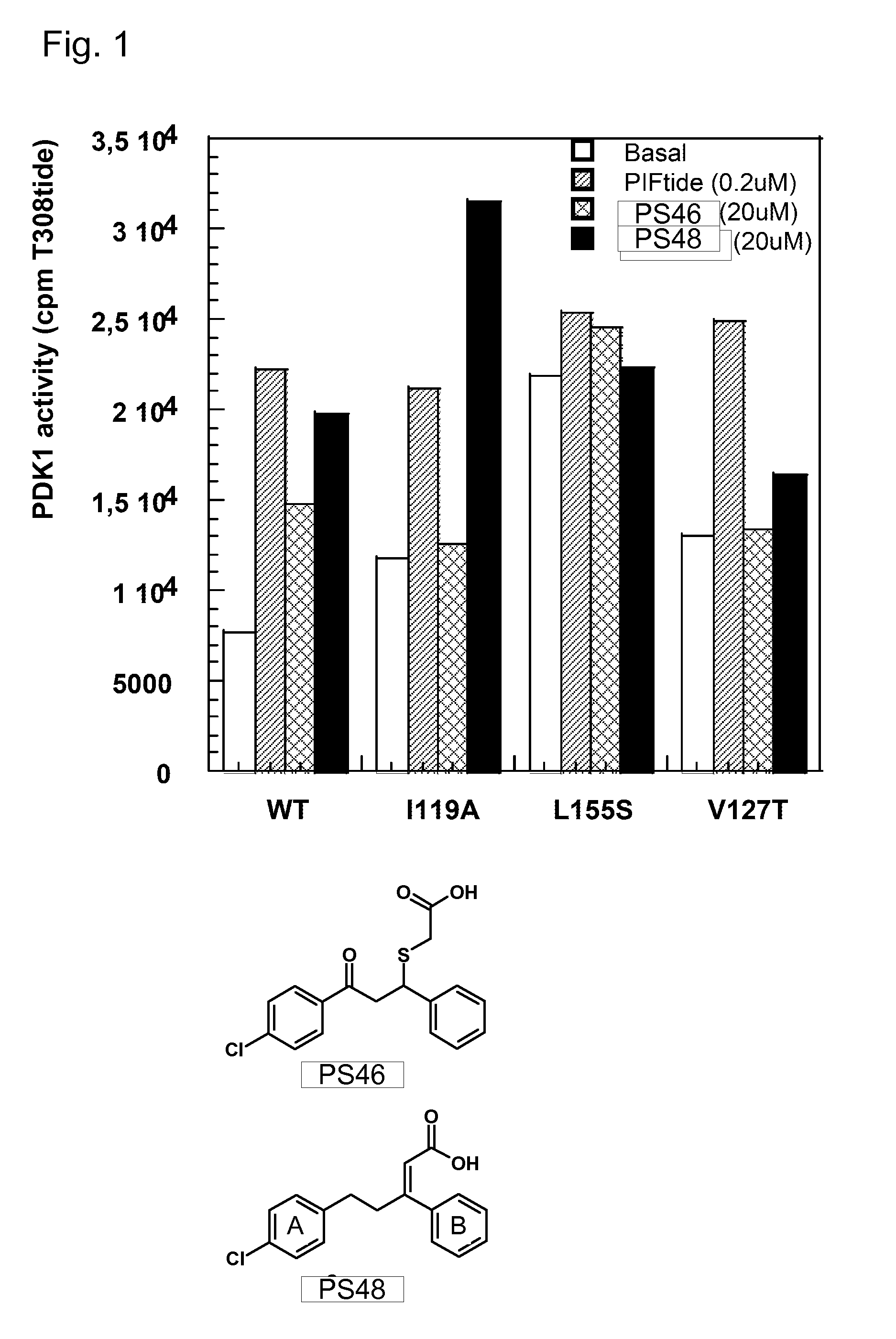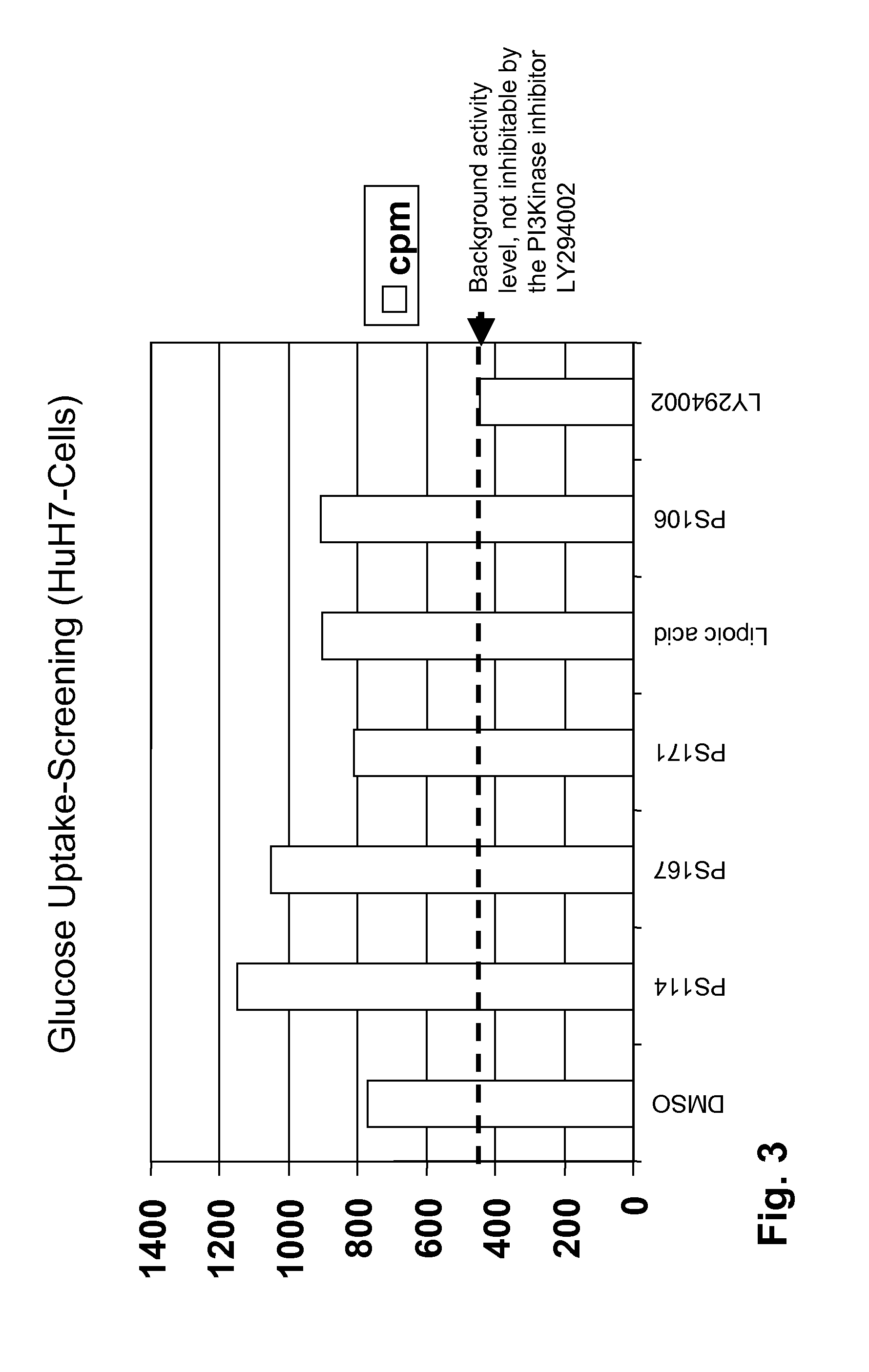Allosteric protein kinase modulators
a technology of allosteric protein and kinase, which is applied in the direction of transferases, antiinfectives, botany apparatuses and processes, etc., can solve problems such as unwanted side effects
- Summary
- Abstract
- Description
- Claims
- Application Information
AI Technical Summary
Benefits of technology
Problems solved by technology
Method used
Image
Examples
example 1
Preparation of AGC Kinase and Aurora Kinase Modulators
1.1. 4-(2-Benzimidazolyl)-3-(4-chlorophenyl)butanoic acid•HCl (PS 153)
[0143]
1) 3-(4-Chlorophenyl)glutaric anhydride: The suspension of commercial 3-(4-chlorophenyl)glutaric acid (15 g) in acetyl chloride (20 ml) was heated to reflux for 2 h. Then precipitation of the product is completed by addition of petrol ether (50 ml) and cooling to rt. The precipitate is isolated by suction filtration, washed with petrol ether, and dried in vacuo to give 3-(4-chlorophenyl)glutaric anhydride (13.3 g) as colourless crystals.
2) N-(2-Aminophenyl)-3-(4-chlorophenyl)glutaramic acid: The solution of commercial 1,2-phenylenediamine (1.08 g) and 3-(4-chlorophenyl)glutaric anhydride (2.25 g) in 1,4-dioxane (7 ml) was stirred at rt for 10 min. A voluminous precipitate is formed which is kept at rt for further 50 min. The thick slurry is heated to reflux with methanol, cooled to rt, isolated by suction filtration, and washed with methanol. After drying...
example 2
Activation or Inhibition of Different Protein Kinases of the AGC Family
[1113]Principle of the cell-free kinase activity assay: In general, the activity of the compounds as protein kinase inhibitors or activators may be assayed in vitro (cell free assay is meant here), in vivo or in a cell line. In vitro assays include assays that determine inhibition or activation of either the phosphorylation activity or ATPase activity of the activated protein kinase. Alternate in vitro assays quantitate the ability of the inhibitor to bind to the protein kinase. Compound binding may be measured by radiolabelling the compound prior to binding, isolating the inhibitor or activator / protein kinase complex and determining the amount of radiolabel bound. Alternatively, inhibitor or activator binding may be determined by running a competition experiment where new compounds are incubated with the protein kinase bound to known radioligands. Newer methods comprise fluorescence polarisation assays and surfa...
example 3
[1114]For PS 48, which represents one example compound according to the invention, it is demonstrated in FIG. 1 that the target binding site is the PIF pocket of the protein kinase PDK1. A kinase activity assay employing T308tide as substrate peptide was performed to measure the effect of compound PS48 on the PDK1 catalytic activity. Compound PS 48 was found to increase PDK1 activity to a similar extent as did the original compound PS 46 (which is not part of the present invention), despite being even smaller (4.3-fold activation, AC50=19.3 μM). In the next step, we corroborated that this activatory effect is exerted via binding of PS 48 to the PIF pocket; for this purpose, some amino acid residues lining the PIF pocket were replaced using site directed mutagenesis. As depicted in FIG. 1, the ability of PS 48 (and of PS 46) to activate PDK1 was lost towards the PDK1V127T mutant, indicating that the compound's binding site in wild type PDK1 is indeed the PIF pocket. As a control, the...
PUM
| Property | Measurement | Unit |
|---|---|---|
| temperature | aaaaa | aaaaa |
| pH | aaaaa | aaaaa |
| pH | aaaaa | aaaaa |
Abstract
Description
Claims
Application Information
 Login to View More
Login to View More - R&D
- Intellectual Property
- Life Sciences
- Materials
- Tech Scout
- Unparalleled Data Quality
- Higher Quality Content
- 60% Fewer Hallucinations
Browse by: Latest US Patents, China's latest patents, Technical Efficacy Thesaurus, Application Domain, Technology Topic, Popular Technical Reports.
© 2025 PatSnap. All rights reserved.Legal|Privacy policy|Modern Slavery Act Transparency Statement|Sitemap|About US| Contact US: help@patsnap.com



